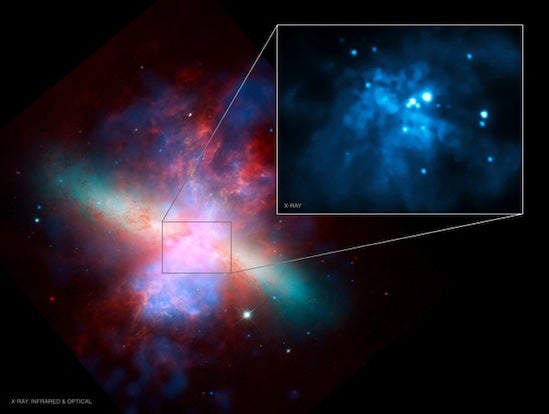But scattered across the universe like oases in a desert are a few apparent black holes of a more mysterious type. Ranging from a hundred times to a few hundred thousand times the Sun’s mass, these intermediate-mass black holes are so hard to measure that even their existence is sometimes disputed. Little is known about how they form. And some astronomers question whether they behave like other black holes.
Now a team of astronomers has succeeded in accurately measuring — and thus confirming the existence of — a black hole about 400 times the mass of our Sun in a galaxy 12 million light-years from Earth.
Richard Mushotzky from the University of Maryland (UMD) said the black hole in question is a just-right-sized version of this class of astral objects.
“Objects in this range are the least expected of all black holes,” said Mushotzky. “Astronomers have been asking: Do these objects exist, or do they not exist? What are their properties? Until now, we have not had the data to answer these questions.” While the intermediate-mass black hole that the team studied is not the first one measured, it is the first one so precisely measured, “establishing it as a compelling example of this class of black holes,” said Mushotzky.
A black hole is a region in space containing a mass so dense that not even light can escape its gravity. Black holes are invisible, but astronomers can find them by tracking their gravitational pull on other objects. Matter being pulled into a black hole gathers around it like storm debris circling a tornado’s center. As this cosmic stuff rubs together, it produces friction and light, making black holes among the universe’s brightest objects.
Since the 1970s, astronomers have observed a few hundred objects that they thought were intermediate-mass black holes, but they couldn’t measure their mass so they couldn’t be certain. “For reasons that are very hard to understand, these objects have resisted standard measurement techniques,” said Mushotzky.
Pasham from UMD focused on one object in Messier 82, a galaxy in the constellation Ursa Major. M82 is the closest starburst galaxy where young stars are forming. Beginning in 1999, a NASA satellite telescope, the Chandra X-ray Observatory, detected X-rays in M82 from a bright object prosaically dubbed M82 X-1. Astronomers, including Mushotzky and Tod Strohmayer of NASA’s Goddard Space Flight Center in Greenbelt, Maryland, suspected for about a decade that the object was an intermediate-mass black hole, but estimates of its mass were not definitive enough to confirm that.
Between 2004 and 2010, NASA’s Rossi X-Ray Timing Explorer (RXTE) satellite telescope observed M82 X-1 about 800 times, recording individual X-ray particles emitted by the object. Pasham mapped the intensity and wavelength of X-rays in each sequence and then stitched the sequences together and analyzed the result.
Among the material circling the suspected black hole, he spotted two repeating flares of light. The flares showed a rhythmic pattern of light pulses, one occurring 5.1 times per second and the other 3.3 times per second — or a ratio of 3:2.
The two light oscillations were like two dust motes stuck in the grooves of a vinyl record spinning on a turntable, said Mushotzky. If the oscillations were musical beats, they would produce a specific syncopated rhythm. Think of a Latin-inflected bossa nova or a tune from The Beatles’ White Album: “Mean Mister Mustard sleeps in the park, shaves in the dark, try’na save paper.”
In music, this is a 3:2 beat. Astronomers can use a 3:2 oscillation of light to measure a black hole’s mass. The technique has been used on smaller black holes, but it has never before been applied to intermediate-mass black holes.
Pasham used the oscillations to estimate that M82 X-1 is 428 times the mass of the Sun, give or take 105 solar masses. He does not propose an explanation for how this class of black holes formed. “We needed to confirm their existence observationally first,” he said. “Now the theorists can get to work.”
Though the Rossi telescope is no longer operational, NASA plans to launch a new X-ray telescope, the Neutron Star Interior Composition Explorer (NICER), in about two years. Pasham has identified six potential intermediate-mass black holes that NICER might explore.










